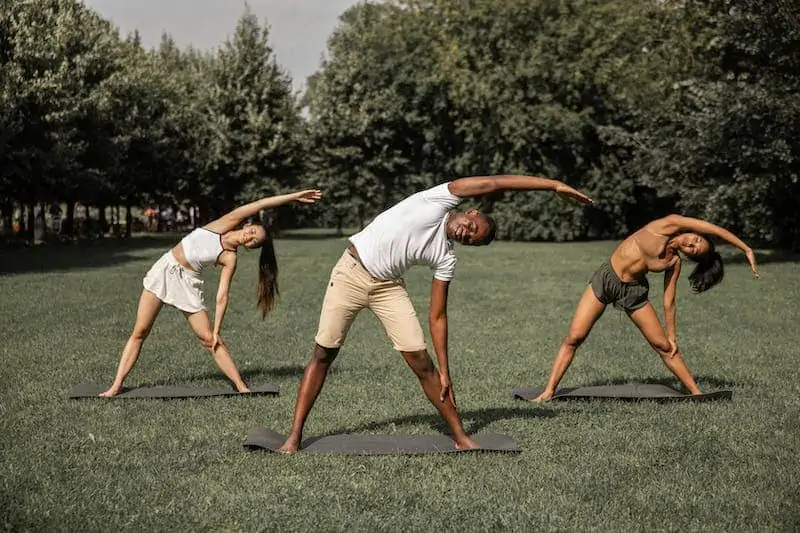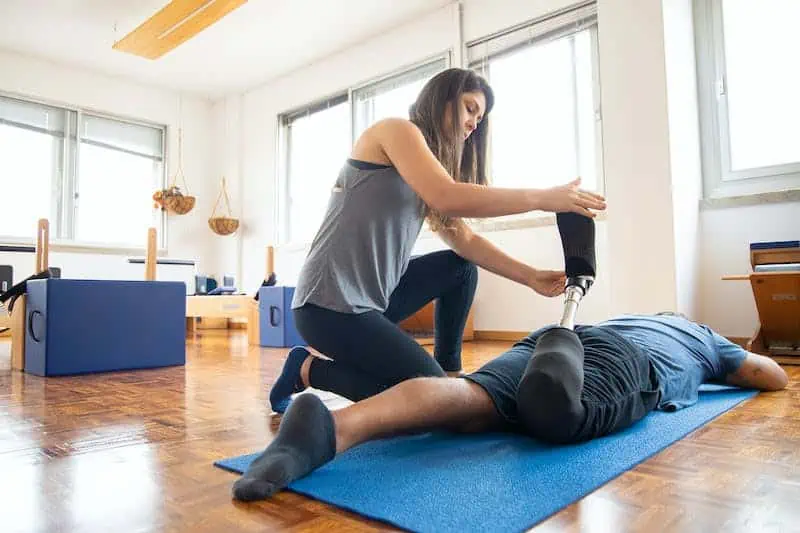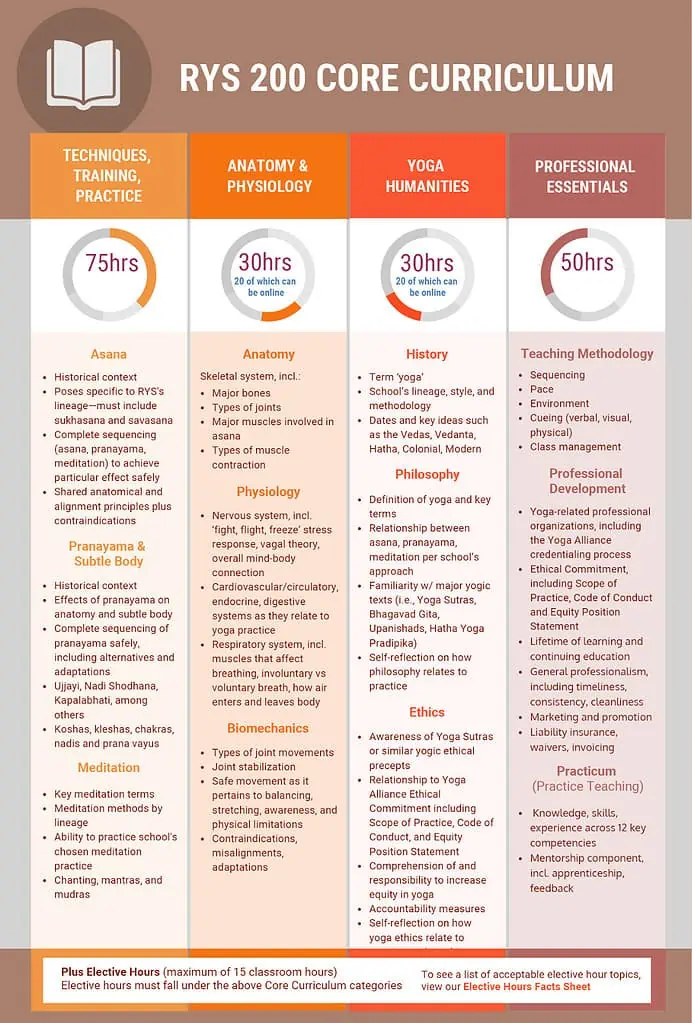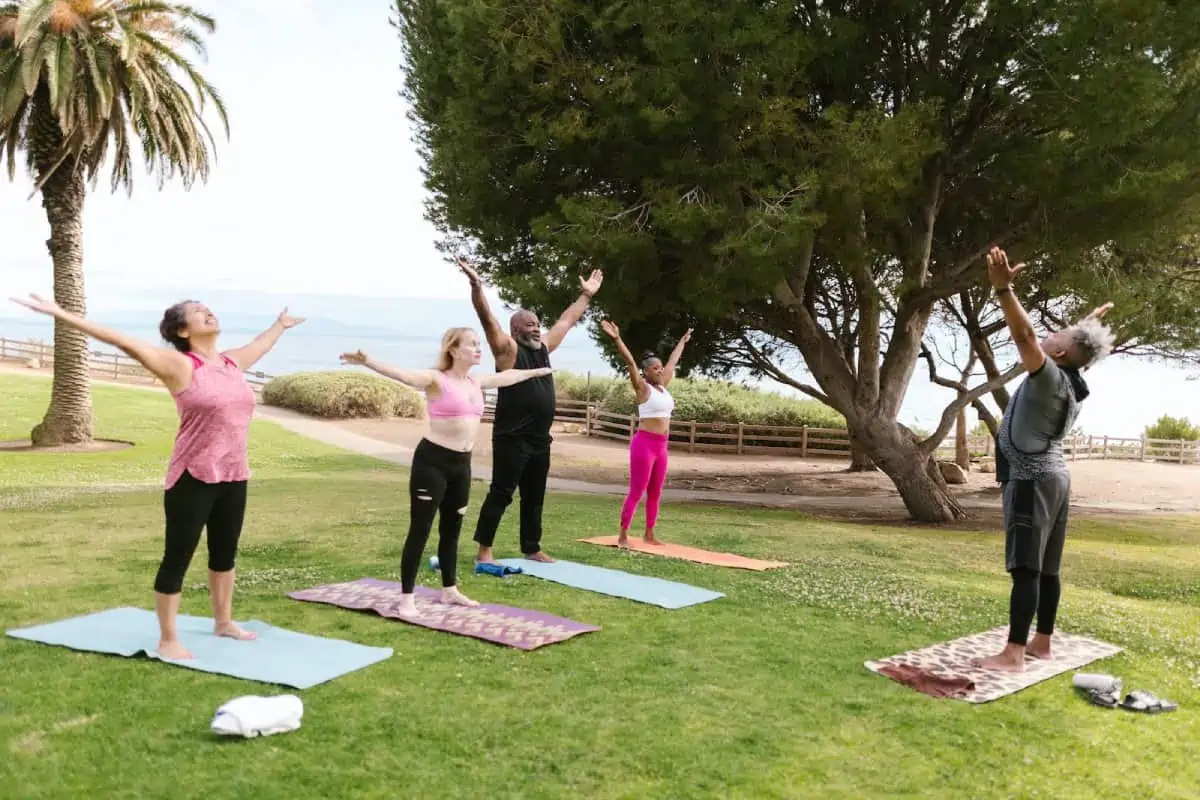Listen to this article:
You walk into your yoga class and the teacher is there at the front. Waiting for you with a warm smile and sweet introduction. You will listen to their voice and their cues for the next 60-90 minutes. Guiding you through a restorative flow or a powerful practice, you trust them to have the best intentions. But who are they, really?
Contents
Know The Difference: Yoga Teacher, Yoga Instructor, Yoga Therapist
Have you ever been curious about what makes the person at the front of your yoga class qualified to lead you through your flow? What is a yoga instructor called?
All of the different terms and titles in the yoga world are confusing. Truthfully, most can be used interchangeably. But there are some distinctions.
Who is this person cueing you through Surya Namaskar A? Are they a yoga teacher? Yoga instructor? Or a yoga therapist?
Yoga Instructor

A yoga instructor has the least amount of formal training and knowledge regarding yoga. They spend the most time on their yoga mat, demonstrating the poses. A class with a yoga instructor will include less explicit teaching about how to get into each pose safely and comfortably.
Often their practice is limited to asanas (yoga poses) because they did not undergo formal teaching about yoga philosophy. If you have ever let your friend lead you in yoga just for fun, they were technically your yoga instructor, not your yoga teacher.
Yoga Teacher

Unlike a yoga instructor, a yoga teacher is someone who has gone through formal yoga teacher training and is certified or registered to teach yoga. Their training could have been in any number of yoga styles including Hatha Yoga, Vinyasa Yoga, Ashtanga Yoga, Kundalini Yoga, Yin Yoga, Yoga Nidra, or Bikram Yoga. Yoga Alliance-certified teacher trainings start at 200 hours.
A yoga teacher has a lot of knowledge and training about yoga holistically- asanas, pranayama (breathing exercises), meditation, and philosophy. Therefore, they spend more time in class teaching the students how to get into each pose. Yoga teachers use lots of cueing and metaphors (“imagine there is a string on the crown of your head pulling you up into the sky”) to get their students into poses.
They also have the knowledge to recommend variations to people based on their ability and injuries. They spend more time off their own mats during class, giving more personalized and specific instruction to students and even offering them hands-on adjustments.
A quality yoga teacher will also incorporate other yoga practices into a class than just asana- like pranayama and meditation. Often, they will incorporate a theme into class as well that is rooted in yoga philosophy, such as ahimsa (non-harm) or aparigraha (non-attachment).
This is not to say that if your yoga teacher is staying on their mat during class, they are not trained or not a high-quality teacher. They might be a new teacher, as it takes a lot of experience to be able to cue a flow without doing it yourself. Or, if the class is more advanced it might not be necessary to offer a lot of cues and adjustments.
Most yoga teachers combine the instructing and teaching style.
Yoga Therapist

A yoga therapist is the most specialized of these three terms, and the only one that should not be used interchangeably. They differ from yoga teachers and yoga instructors considerably. A yoga therapist is someone who uses yoga practice and yoga philosophy to promote physical and mental health and wellbeing to individual or small group clients.
Their services include personalized assessment, goal settings, and lifestyle management. They work with individuals with chronic pain or injury, mental health struggles, and addiction. Yoga therapists must undergo up to 2,500 hours of training and education.
A yoga therapist is a specialist outside the regular yoga studio setting, so the rest of this article will focus on yoga instructors and teachers.
Registered Yoga Teacher Vs. Certified Yoga Teacher
A certified yoga teacher (CYT) completed formal yoga training. Whatever yoga school they chose, they completed the full amount of hours and mastered the skills that were set by that school. They received certification and can teach yoga classes.
Registered yoga teachers (RYT) completed their formal training with a yoga school that is certified by the Yoga Alliance. I will explain more about the Yoga Alliance in the following section.
Either way, a yoga teacher should receive a certificate of completion from their chosen yoga school. Although a person does not technically need a certificate to teach yoga classes, it is important to attend yoga teacher training if you would like to become a yoga teacher. You will gain valuable knowledge about anatomy, alignment, philosophy, and business.
What Is The Yoga Alliance?
Once yoga hit the West, particularly in the United States, it soared in popularity. A group of yoga teachers realized that the requirements and criteria to become a yoga teacher needed to be regulated. Schools were popping up all over the place with yoga teacher training programs that ranged in quality a startling amount.
Many teacher trainings ignored the ancient yogic philosophy altogether. Many gyms were claiming to offer yoga classes that were more like exercise classes. A misunderstanding of what a true yoga practice looks like was widespread.
In 1999, Yoga Alliance was formed as a way to promote quality and intentional training of yoga teachers in the West. They created a curriculum of standards recommended for yoga schools. If yoga schools want to apply to be a “registered yoga school” or RYS- they must adhere to these standards.
In 2007 Yoga Alliance went international. Today, they are the gold standard for teacher training.
Seeking out a registered yoga school with Yoga Alliance is most people’s number one priority when deciding where to go for yoga teacher training.
It is worthwhile to note that this is an American-born organization leading the charge for an ancient and sacred Indian practice. Their mission to formalize the criteria and standards for yoga teacher training programs was a necessary step for the globalization of a quality yoga practice.
However, you would be hard-pressed to find an Indian guru who is registered with Yoga Alliance. Ancient lineages of gurus and masters do not adhere to these westernized standards and they should not be expected to in order to maintain legitimacy. Practicing respect and cultural humility to the original servants of this practice is of the utmost importance.
Letters And Numbers And Dashes- Oh My!
Quite simply all of those numbers and letters you see after a yoga teacher’s name represents the level of certification they have with Yoga Alliance.
RYT 200
A registered yoga teacher who completed a 200-hour training through a registered yoga school.
E-RYT 200
A 200-hour registered yoga teacher who also has taught at least 1,000 hours of yoga classes, and has been teaching yoga for 2 years after their initial training. The ‘E’ stands for ‘experienced.’
RYT 500
A registered yoga teacher who completed 500 hours of training (often broken up into one 200-hour yoga teacher training, and a subsequent 300 hours of training) through a registered yoga school
E-RYT 500
A registered yoga teacher who has taught at least 2,000 hours worth of yoga and has been teaching yoga for at least four years.

Are All Yoga Teachers Gurus or Yoga Masters?

This is a complex question with a complex answer. A guru is a spiritual teacher who will guide you on your spiritual journey toward healing, self-realization, and freedom. They can only offer you as much guidance as experience and knowledge that they have. Generally speaking, your yoga instructor in your neighborhood studio will be limited in the amount of spiritual guidance they can offer.
But that doesn’t mean they can’t play a significant role in your journey. They might introduce you to tools such as clearing energy blockages through yoga asana, grounding exercises through pranayama, and transformative meditation and philosophy.
The Masters and the Enlightened Masters are rare. They have walked the spiritual path for years. They have reached the ultimate goal of detachments from suffering and desire, they live in pure bliss, free of ignorance and delusion.
Be wary of those who must claim this state loudly- as the ego may be at plat there. And a true master is free from the ego. A true guru does not demand devotees, but simply attracts them with their air of compassion, pure joy, humility, and knowledge.
In truth, your guru should guide you towards your one true guru- yourself. You are an enlightened being who simply needs guidance to overcome the darkness heaped upon you by this world.
Responsibilities of A Yoga Instructor or Yoga Teacher
Regardless of what your yoga instructor is called, how they are certified, and through what organization, they should all follow some foundational responsibilities.
- Complete a comprehensive yoga teacher training
- Create a safe environment for the yoga class
- Offer variations and adjustments to keep you safe
- Be honest about their scope of practice
- Have an understanding of the philosophy of yoga
- Understand the physiology of the body
- Honor the ancient origins of yoga
- Behave in an ethical manner
- Share the benefits of yoga practice



